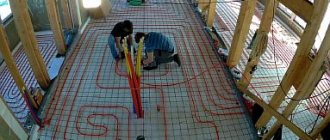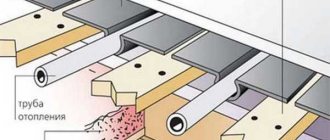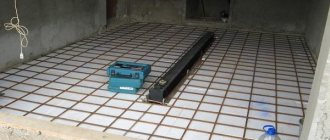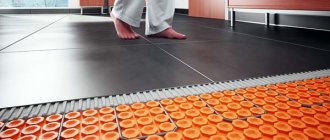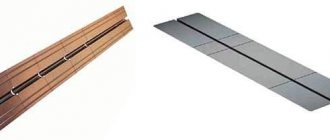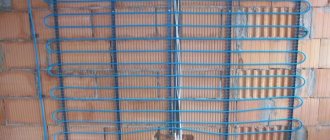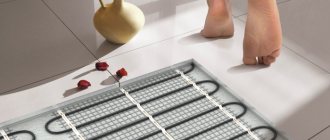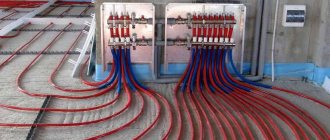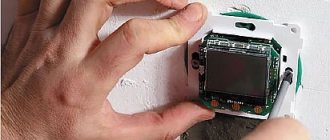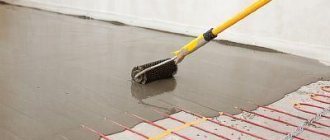The promising idea of a frame house is becoming increasingly popular in our country. Along with the growing interest in this topic, new technologies are emerging to improve the functionality of the home, increase comfort, and modernization opportunities. Traditional floors include heated floors in a frame house, the possibility of which was considered a fiction just a few years ago.
The problem was that the floor of a frame house could not be covered with a strong concrete pad. The limiting load on the frame does not allow the installation of conventional types of floor coverings in individual rooms. At the moment, engineers have solved this problem. A version of electric and water floors adapted for frame houses is available for purchase and installation.
What is a heated floor?
For a house built using a frame system, heat loss through the floor is possible for several reasons:
- Problems with the strip frame;
- Small thickness of concrete pad;
- The presence of cold bridges due to the characteristics of the frame.
In order to avoid serious heat losses and be able to regulate the temperature of the floor covering, a heated floor is poured at the final stage of construction. This is a complex system that not only ensures uniform heating of the floor plane, but also prevents the loss of large amounts of heat. Due to the characteristics of frame houses, installing heated floors has its own characteristics.
Installing such a system requires a high level of skill and experience, because the process has a low margin for error.
Wall insulation
The insulation of the walls of a frame house is fundamentally different from the insulation of monolithic walls made of brick or timber. The insulation is placed in the cavities formed by the frame, regardless of the technology used.
Basic frame technologies:
- Panel
- Framework
In the first case, the shields are monolithic elements consisting of sheathing sheets and insulation sandwiched between them.
In the second case, a frame made of boards acts as a load-bearing element, in the cavity of which insulation is laid.
The panels have a rigid structure, so they can contain structurally strong insulation, such as sheets of foam plastic (also called polystyrene foam).
Frame frames are subject to some changes in geometry due to wood shrinkage and loads on them. The use of foam plastic in them is not recommended, since it can collapse when the racks are deformed due to the hinge of the entire structure. The main material for thermal insulation of frame frames is loose mineral wool.
Insulation of frame walls
Fixing mineral wool in the cavities of frame frames is somewhat difficult: after all, the walls are vertical. Especially these are the loosest varieties of mineral wool. Its installation is carried out after covering the walls of the frame from the outside or inside. To strengthen the insulation, special disc-shaped dowels are used. If you choose dense varieties of mineral wool, they are well held between the posts due to their dense structure. But denser varieties also have higher thermal conductivity and weaker protection from the cold.
Note that for a tighter fit of the mineral wool to the posts of the frame frame, it should be laid with an overlap of about 5-10 cm. This prevents the occurrence of cold bridges on the posts themselves, since the thermal conductivity of wood is much higher than that of mineral wool.
Thus, insulation of walls from ready-made panels is carried out by fixing the insulation between the sheathing sheets already during their production. Insulation of frame frames is carried out by laying insulation in the cavity of the frame during the construction of the frame.
Determining the type of coating required
There are two main types of heated floors:
- Water, using a pipeline system;
- Electric.
They are characterized by their own nuances in operation, characteristics, and installation process. The most popular is the first option. A heated water floor in a frame house performs well for decades, can be flexibly configured, and its installation does not cost a lot of money.
The water floor is a complex system of tubes that are laid on a reinforced mesh in the form of a twisted spiral, even at the stage of pouring the floor. Each room can have its own heating system with different pipe laying pitches, total heated area, etc. The network of pipes must be connected in a certain place, usually a boiler room, from where the liquid inside the PVC pipes is heated.
Installing such a system throughout the entire living area of the house guarantees the possibility of passive heating of the building in winter. With active use, heat loss through the foundation of a house can be reduced to zero.
The water heating system has several strengths:
- Low cost of maintenance, ease of installation;
- Easy to maintain, flexible in setting the temperature for each individual room;
- Possibility of heating both from the network (autonomous heating) and from a wood stove (boiler);
- High durability of the installed system. With proper maintenance, a water floor will last more than 20 years.
A warm floor in a frame house should be light in weight and not put pressure on the wooden frame. The limiting load for a building made of 15cm boards is 320 kg/m2. In order to meet this limit, several types of installation are used: installing a light floor on a wooden floor or installing a contour in a floating screed.
Both options can be used in a frame house that stands on stilts. However, for houses with strip foundations it is better to use the so-called. "easy".
Selection of materials and wood requirements
The most common flooring materials are coniferous species - spruce and pine. The beams and boards made from them are strong, reliable and lightweight, and the resin contained in the fibers reliably protects against rotting. In addition, the cost of the material is relatively low.
But if you have a sufficient budget, I still recommend using hardwood. Boards and beams made of oak or aspen, although heavier, are much stronger and more durable. Oak must be used for the construction of heavy and large frame houses.
For ease of perception of information, the table shows the most important criteria for evaluating flooring materials and recommendations for their use.
| Evaluation criterion | Recommendations and explanations |
| Material | Coniferous species (spruce, pine). Inexpensive option, suitable for small spaces. Characterized by durability and sufficient strength |
| Oak, aspen. Medium and high price segment. Performance characteristics significantly exceed those of coniferous species. Aspen, as an environmentally friendly material, is recommended for children's rooms and bedrooms | |
| Humidity level | For the floors of a frame house, especially in living rooms, only dried material is used. Wet wood will inevitably lose volume, which will lead to gaps in the coating |
| Appearance | When purchasing material, you must carefully inspect it and make sure there are no cracks, splits, or suspicious stains. I do not buy and do not recommend purchasing such wood, even if the seller offers a significant discount |
Installing an insulation loop in a “floating” screed
A common type of installation, which is characterized by ease of execution and wide possibilities for adjusting heating indoors. How to make a warm floor in a wooden frame house with a solid foundation? The algorithm for performing the work looks like this:
- The floor is sewn up with an even layer (5cm) of screed, on which further work will be carried out;
- Waterproofing is installed (polyethylene film or special PVC-based waterproofing);
- An even layer (up to 10 cm) of insulation is laid - polystyrene foam or another roll type;
- A reinforcing mesh is installed - it provides rigidity to the structure and distributes the force over a large area;
- A pipeline is being laid (the distance between the pipes is from 10 to 30 cm). PVC pipes are attached to the mesh with clamps or nylon ties;
- Pressure testing is carried out (pipes are filled with water, the system is tested);
- The floor is poured with an even layer of screed (3-5 cm), while the pipes are under pressure.
Further treatment of the floor depends on the wishes of the owner.
The most advantageous covering would be board, linoleum, ceramic tiles, etc. The installation of a heated floor in a wooden frame house takes into account the characteristics of the building.
This installation method is well suited for large houses with a strong foundation. The total weight of the structure will be about 400-500 kg/m2, which may be acceptable for houses with a solid foundation.
Base insulation process
High-quality thermal insulation of the basement floor plays an important role in creating a comfortable atmosphere in the house. If cold air masses do not penetrate under the building, then it is natural that the heat will be better retained inside the building.
The work of insulating the basement is carried out in the same way as insulating the walls. But in addition to the vertical arrangement of the thermal insulation material, it must be placed under the blind area.
Base insulation technology:
the soil is compacted under the house and a 10 cm sand cushion is poured;
for the base, a frame 15 cm thick is prepared, and the inside is sewn up with plywood;
- a vapor barrier is laid from the blind area to the top of the plinth, its seams are taped, and the material itself is attached to the boards with a stapler;
- along lighthouses with a slope from the house, expanded clay is poured onto the blind area, 10 - 15 cm thick;
a concrete screed is poured on top of the expanded clay;
- after the cement has dried, boards 50 cm high are placed on the outside of the base;
- a hydraulic layer is laid inside the resulting well;
- expanded clay is poured in and covered with the edge of a waterproofing film;
the base is sewn up with boards to the end, and covered from above.
A house on stilts insulated in this way will be inexpensive, but will well protect the base of the building from frost.
Installation of lightweight heated floors
This method is preferable for small houses on a strip foundation. The main difference is the low weight of the structure (about 100-150 kg/m2). The installation is carried out in several stages, where the main labor-intensive task will be the calculation of the required number of turns of PVC pipes and the installation of a wooden frame under them.
Work plan:
- The subfloor is covered with a thick layer of waterproofing;
- Thick insulation is laid - foil polystyrene foam.
The wooden frame is installed using one of the available methods:
- Completely covering the shelf with a board, then sawing through the channel for the pipes
- Laying boards in a “labyrinth”, laying PVC pipe between the boards
- After this operation, a rough test of the system is performed. A successful test allows the floor to be covered with a finishing coating;
- A thin layer of metal is attached to nails or screws. This is necessary for uniform heat dissipation in the room;
- The system is covered with a double layer of plywood, OSB, dried boards, etc.;
- The covering is laid - boards, linoleum, etc.
This type benefits from the speed of installation, simplicity, the ability to quickly repair the system and the general idea. The pipeline for each room is routed separately to its own “comb” and can be connected to any type of heating: electric, solid fuel, gas.
Using a pump to circulate water throughout all rooms will speed up heating and save some energy during long-term heating.
Do-it-yourself flooring of a frame house. Device and step-by-step instructions
Floor supports and beams
Beams are the main support elements on which logs are laid. Supports are wooden pillars installed on concrete that serve to stabilize the beams and protect them from contact with concrete. These elements are made from coniferous wood impregnated with a bioprotective composition.
- We mark the supports. To do this, draw a plan of their location, indicating the height. We stretch the string along the line where the supports are located, securing it to the beams where the cuts for the beams are made. We measure the height of each support and record the results in the plan.
- We cut the timber 100 x 100 mm in accordance with the measurements. We place the blanks in their places, laying a layer of waterproofing material on the base. We nail the supports to the wooden inserts made during pouring.
- We place the beams end-to-end in the pocket, using inserts to adjust their height flush with the beds. If the workpieces are long, mark the second end of the beam and cut off the excess. If they are short, then we join the beams on a support.
- We attach the beams to the beams and intermediate supports with corrugated nails. If the height of the supports is more than 1 m, we strengthen them with bevels from the board.
Strapping and logs
We also make the strapping from 50 mm boards, the width depends on the planned load and the thickness of the insulation.
- We lay the trim along the sides of the house, parallel to the floor beams. We place the boards on their ends, align them along the outer edge of the planks and fasten them to them with nails at 20 cm intervals.
- We mark the location of the logs. We measure 40 cm from the corner along the laid trim board. We lay out the boards for the joists on the beams, place them on the side plane and align them according to the markings.
- If the length of the board covers the length of the building, on the other side we carry out the markings in the same way. We cut the logs and fasten them with nails to the frame and planks, check them and fasten them to the beams at the intersection.
- If the size of the building is larger, then we overlap the logs. The joint should be on the floor beam. We cut 30 cm intermediate joists and nail the joints together, using the scraps as spacers. Then we fix the logs to the floor beams.
Floor insulation
The optimal material for insulation is mineral wool. Its disadvantage is the loss of thermal insulation ability when wet. Therefore, we protect the insulation layer with a vapor-waterproofing and windproof film.
If low-density insulation is selected, we sew a subfloor treated with bioprotection under the joists.
- We lay the vapor barrier film across the joists with sagging, which will allow us to lay insulation between the joists. We glue the joints of the strips with tape and secure the film with a stapler.
- We place insulation boards between the joists, leaving no gaps. When laying insulation twice, use a second layer to cover the joints of the first.
- We put a waterproofing film on top of the insulation and fasten it with staples, protecting against liquid leakage in the house.
Features of water floors
The circulation of fluid beneath the surface of a home is the reason many people install electric heating systems. The fear of a complex system failing, which can damage the foundation after a breakdown, is quite justified - due to improper pipe laying, the use of materials of dubious quality, or miscalculation at the construction stage. For good balancing of the house, the system can only be installed on:
- Smooth surface;
- Separate circuit for each room;
- Heating the entire building or filling other rooms with screed.
Correct weight distribution will protect against sagging of individual parts and frame breakage due to excessive pressure. It is possible to install a warm floor in a frame house with your own hands, but for water systems you will need an assistant with experience - working with PVC pipes requires special skills and understanding of this material.
Adviсe
To install the floor on the second floor of a frame building, you should follow the recommendations for performing the work, which are somewhat different from the technology for creating the floor on the first floor.
It should be noted that the main task of the floors on the second floor will be to create high-quality sound insulation. Therefore, instead of the usual insulation in the interfloor ceiling, it is necessary to use a soundproofing layer. The most suitable raw material for such work will be sand, which meets the necessary characteristics and, in addition, is an excellent heat accumulator. A high level of floor rigidity is also important.
To ensure such qualities, the base, in addition to beams, should be strengthened with lags, which will add strength to the structure.
The technology for installing the floor on the second floor involves performing the following work:
- installation of the rough foundation to the interfloor beams;
- laying waterproofing and vapor barrier;
- Insulation and raw materials providing sound insulation are installed in the gaps between the beams. In some cases, expanded clay is used instead of sand;
- floor joists are installed on the beams;
- the distance between the logs is carefully filled with raw materials for insulation. For such purposes, mineral wool or any other building material with high non-flammability is usually used;
- A waterproofing film is laid on top of the insulation, which will prevent the formation of moisture leakage to the first floor in the event of unforeseen situations, for example, a leak in the roof;
- The pie is sewn up with a board, plywood or other material suitable for further work on laying the finishing floor covering.
Some builders recommend simplifying the floor structure of the second floor by using reinforced beams for interfloor floors. I-beam wooden products are considered such products. When creating such a structure, installation of logs is not required. The beams are covered with boards, and soundproofing material is laid between them, which must be sealed.
By studying the properties of building materials, you can avoid mistakes when arranging the floor in a frame house, since the competent combination of raw materials into a single structure will ensure a high level of comfort in a home of this kind.
Electric floor
Floors with a solid-state heating element are an alternative to water floors. Unlike complex pipe systems, this method offers uniform heating of the house area using special grilles.
Among the wide range of electrical systems there are:
- Cable systems;
- Heating mats;
- Infrared mats;
- Infrared film.
The installation of each type has its own nuances. The main difference between them is the type of heating element; for mats, the thickness of the floor covering plays a role.
How to select and calculate pipes
Before you begin independent work on the construction of a hydrofloor, you should choose the right type of pipes and calculate the optimal diameter size.
Pipes for heated floors. Recommendations from experts // FORUMHOUSE
Watch this video on YouTube
Types of pipes
Today, a large number of types of pipes are produced for installation in water-heated floors; they are made of various materials.
Professionals advise that when installing yourself, give preference to cross-linked polyethylene pipes such as PEX or PERT. The ideal option is PE-Xa, which has the highest cross-link density (85%).
This makes it possible to use axial fittings that have a sliding end; they can be safely mounted in a concrete structure. In addition, if such pipes are broken, it is not difficult to return them to their original shape using a hair dryer by heating the broken area.
Read the article: there are situations when it is necessary to connect pipes together in a screed, a pipeline has been pierced or you need to extend it - find out how to do this.
PERT circuits do not have a memory property, so it can only be used with push-in fittings, which are not recommended to be hidden in a screed. But if the system is assembled from solid pipes, then the connecting nodes will only be on the manifold, and this type of pipe is quite suitable.
When installing water systems, experts recommend using the PE-Xa or PERT model with a polyvinylethylene layer, which can be on the outside or inside. It is better to install pipes with an inner layer of EVOH.
In addition, metal-plastic pipes are often installed - the price is not expensive and they are not difficult to install. There are copper pipe products that are more expensive and require protection from alkaline exposure when pouring concrete mortar.
Another type of pipe recommended for heated floors is composite. They consist of two layers of cross-linked polyethylene with foil between them. The presence of inhomogeneous material that has a different expansion coefficient when heated can cause delamination of the circuit.
When choosing a model, you must consider:
- brand (Rehau, Tece, KAN, Uponor) is a guarantee of quality;
- labeling;
- certificate of conformity for products;
- take into account the coefficient of thermal expansion of pipes;
- cost of components required for installation.
Pipe size calculation
For water floors, three main pipe sizes are available: 16*2, 17*2 and 20*2 mm. The most popular sizes for installation are 16*2 and 20*2.
Before purchasing a heating circuit, you should calculate the size. If you are not sure that you can do it correctly yourself, it is better to entrust it to professionals. To do this, you need to decide:
- with a diagram of the location of the water heated floor;
- with areas of the floor where furniture will be placed and plumbing installed (pipes are not installed under furniture).
A product with a diameter of 16 mm should have a contour no more than 100 meters long, with 20 mm - 120 m. That is, each should occupy a maximum of 15 square meters. m, otherwise the pressure in the system will be insufficient.
If the room is large, it is divided into several circuits. They must be the same size, the difference is allowed within 15 meters. If there is good thermal insulation, the standard laying step is 15 cm, it is permissible to reduce it to 10 cm.
During the laying step:
- 15 cm - you will need 6.7 meters of heating element per 1 sq. m;
- 10 cm - 10 m.
In addition, when calculating the size of a water floor, heat loss, system power, material of pipes, ceilings and flooring are taken into account.
The standard formula for determining the size of the circuit is the heated area in sq. m. need to be divided by the laying step in meters. To this indicator add the size of the curls and the distance to the collector.
Cabling
This option is very similar in concept to a water floor. A special cable is installed directly under the floor covering in several ways:
- Two-core;
- Single-core;
- Three single-core.
The heat distribution and heating speed depend on the type.
System design
- A boiler used for heating. If the choice fell on water floors, then it is possible to use a solid fuel, electric or gas equipped boiler. They are practical and quite comfortable. Their use implies the absence of a constant supply of fuel, which is used in wood and solid fuel boilers.
- If you plan to create a truly warm house, then it is recommended to use combined systems that will allow you to heat both the radiators and the floor layer. Its temperature regime may differ, since the temperature in radiators can reach 60°C, but for wooden coverings the maximum is 30°C. If this condition is not met, the tree will crack quite quickly.
Laying algorithm
The rough surface is covered with an even layer of waterproofing, overlapping the wall:
- Reinforcing mesh is installed;
- The cable is mounted to the mesh using clamps and nylon ties;
- The heating cable is tested;
- Another layer of reinforcing mesh is installed;
- The surface is covered with a layer of OSB or plywood.
Other types of heating elements are laid in a similar pattern. It only makes sense to cover the floor with ceramic tiles in rooms with a heating mat installed. For other types, the weight of the ceramic tile may be excessive, which can lead to failure of the heating element section.
Types of insulation
In addition, determine what moisture resistance the material should have. This determines whether additional waterproofing will be needed. There are many materials for thermal insulation of floors, let's look at the most common and affordable ones, consider the characteristics and features of application for insulating the floors of frame houses:
Don't miss: How to insulate slopes inside a house: what is the best way to finish plastic windows with your own hands, how to plaster and prime them, rather than paste them on top?
Stone wool
- The material is environmentally friendly - obtained from molten basalt.
- The fibers themselves do not absorb water, but due to the porous structure of the material, mandatory waterproofing is required.
- Laying on a non-continuous sheathing is allowed.
- Thermal insulation properties are very good.
- Thanks to its loose structure, it densely fills the space between the joists.
- Additionally, it provides a soundproofing effect.
- Average price.
Expanded polystyrene
- Extruded polystyrene foam is an environmentally friendly material.
- Very good thermal insulation.
- The plates fit well together.
- It is allowed to lay the material on a non-continuous sheathing.
- Easy to cut and install.
- Absolutely does not absorb moisture and does not allow steam to pass through. With a tight installation, you can do without a vapor barrier.
- Not suitable for rodents.
- Modern polystyrene foam is made with fire-fighting additives, so it does not burn, but under the influence of an external fire source it can melt with the intense release of toxic substances.
- Relatively high price.
Expanded clay
- The material is environmentally friendly - it is made from clay.
- Does not absorb moisture, but can condense it.
- Non-flammable material, which increases the safety of the building.
- There is space between the expanded clay granules, which can serve as a refuge for rodents.
- Mandatory wind protection and vapor protection are required.
- The weakest degree of thermal insulation of the described materials.
- Low cost.
- Expanded clay is used if a dry screed will be laid in the house.
Peculiarities
This system is easy to install. You can lay the warm mat directly on the floor joists; you don’t need a screed for the electric floor to work properly. However, the system also has negative sides:
- Consumption of large amounts of energy;
- Slow heating of the floor;
- Rapid failure of sections.
An electric heated floor for use in a frame house is suitable for any type of foundation and is mounted directly under the finishing coating. Its repair is quite simple: when a section fails, it is simply replaced with a new one. The absence of a screed allows access to the heating element at any time.
Users were equally divided in their sympathies. For some, the indicator is the heating rate and variability in the choice of power sources, for others the main argument is the relative cheapness and ease of installation. It is impossible to clearly identify a leader in this dispute. For a specific house project, one of the types described above is suitable.
Tags
heated floors in heated floors in that the floor of the frame water floors are available heated floor water floors Electric floor through the floor is possible heated floors. heated floors have about heated floors include warm floors lightweight heated floors heat loss through the heat loss is poured out of the warm floor. the amount of heat. installation of heated floors Water heated floors heat loss through a frame house a frame house becomes a frame house non-frame houses version of frame houses installation frame house good area of the house guarantees the foundation of the house can frame house must for houses with
than equipment
